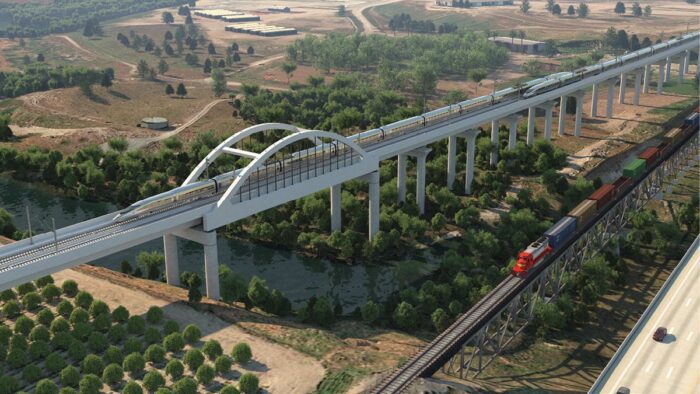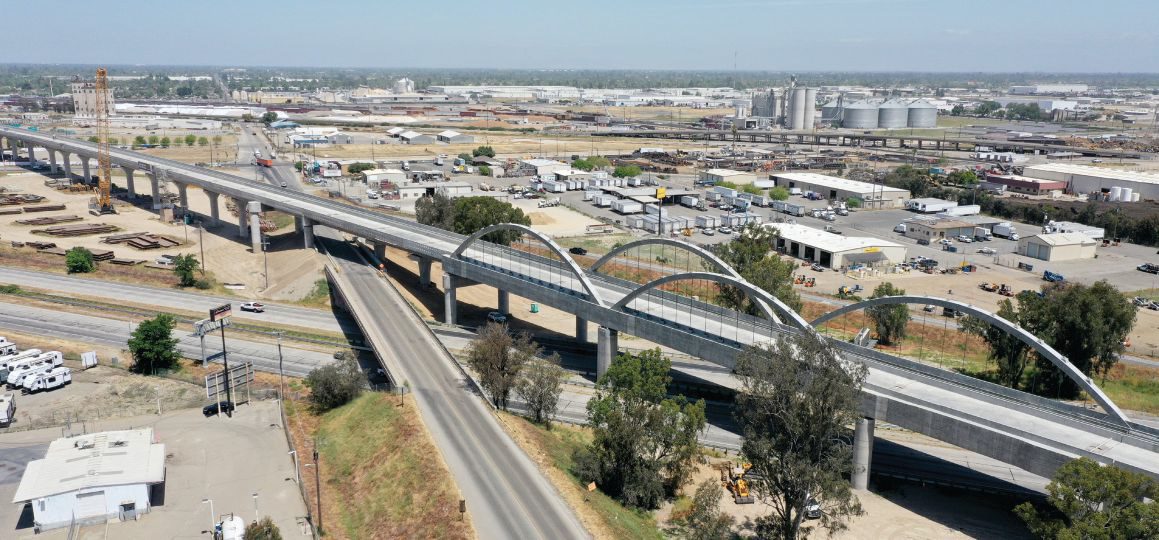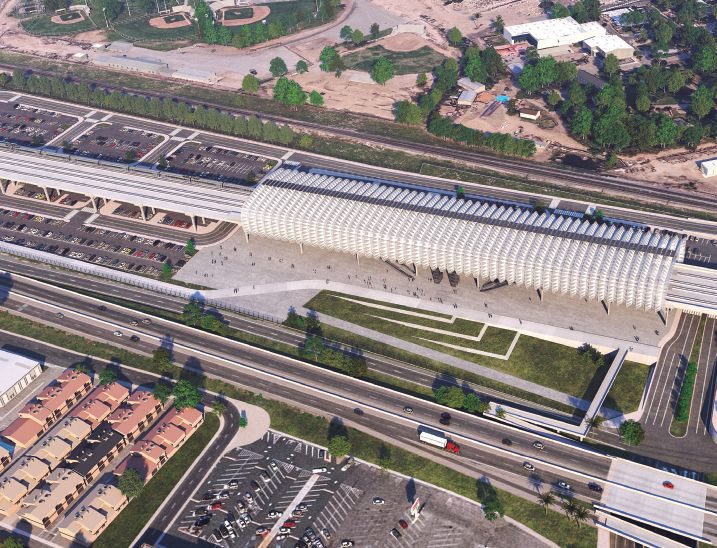Mode Shift: High-Speed Rail Readies for Arrival Across California’s Central Valley

Stretching back to 2008 when Californians voted to invest in electrified high-speed rail, the plan for CA HSR is to connect each of the state’s major population centers faster, safer and smarter than ever before. Along the way, from Merced to Bakersfield, California’s grapevine communities will benefit from an infusion of place-based purpose and forthcoming pride.
Fundamentally, the aim of infrastructure is to make life easier; in an ideal world, equitably for all. Be it a bridge crossing a river, a highway crossing a country or an airport connecting people across the globe, infrastructure can be understood as the “how” to the world’s many “why’s?” wherever we are.
Infrastructure comes to be and thrives based on how well it meets the needs for which it was developed and how long the society that uses it maintains the lifestyle it was built to serve. As such, infrastructure evolves. Changing with time and perspective, infrastructure is a reflection not only of who we are but, indeed, where we’re headed.
In California’s Central Valley, after what seems to be decades of subtle stagnation, it’s time for a mode shift.
“California’s Central Valley, which stretches from Gilroy south of San Jose to Bakersfield north of L.A., has been plagued by high unemployment and poor air quality for quite some time,” says Melissa Figueroa, chief of Strategic Communications for the California High-Speed Rail Authority. Figueroa oversees government relations, external affairs and media for the Authority, and takes personal pride in playing a small part in leaving a lasting impact. “California is creating a truly electric, high-speed rail line with trains that will travel at up to 220 miles an hour. We will be connecting San Francisco to L.A. in under three hours. To date, we’ve created some 11,000 labor jobs along the way.”
The ultimate long-range vision for California’s High-Speed Rail (CA HSR) system is to link each of the state’s mega population regions via single-mode, high-speed transit powered by clean energy. After the initial goal of connecting L.A. to San Francisco is accomplished, the plan extends the system to Sacramento and San Diego. Covering a total of 800 miles and serving 24 stations statewide, CA HSR will connect Californians north to south faster than any other means.
Designing the Stations
Every journey begins with the first step, and then the next. The Authority is proud to continue a march already many years underway by selecting a joint venture of Foster + Partners and Arup to design the stations serving the first four stops on the initial 171-mile segment through the Central Valley. Linking Bakersfield to Merced with stops in Kings/Tulare and Fresno, the partnership is assembled to collaborate with the Authority on the planning, architecture and engineering required to develop the first four stations.
With the intent of developing an engineered “kit-of-parts,” the initial station designs will become the basis for all subsequent stations as the full breadth of the project unfolds over what is likely to be decades. Peter Sokoloff, a partner and architect at Foster + Partners, is joined by John Eddy, a principal and engineer at Arup, in discussing the forthcoming concepts and realization.

Among countless enabling projects, the Cedar Viaduct through Fresno is one of the largest and most-visible structures built to date. Completed in 2023, the overhead viaduct traverses State Route 99 as well as Cedar and North Avenues on Fresno’s southeastern fringe. A few miles further up SR-99, drivers encounter similar arches for the 210-foot span of the San Joaquin River Viaduct—the gateway to the Central Valley.
Sokoloff, a native Californian, grew up in L.A. and has lived in the Bay Area for 12 years. During his 15 years with Foster + Partners, he has focused on transit infrastructure as his niche, committing time to the Bay Area Rapid Transit (BART) system’s expansion to San Jose and developing the visioning plan for CA HSR. As the principal-in-charge, Sokoloff also appreciates the long-term impact his work will have on the state he calls home.
“I got into this line of work to create architecture that improves people’s lives,” he explains. “This high-speed rail system is a public amenity that is equitable, sustainable, practical and economical. Fundamentally, this is going to change the way people live.”

Form following function, the eventual articulation of the canopy will establish a classically California perspective of structurally efficient members. Surf, sand, sun and mountains, the Golden State’s rich outdoor heritage and fun-loving vibe will organically undulate over each destination while making crosstown connections for pedestrian passage.
Eddy, a principal in Arup’s San Francisco office, has been a practicing engineer for 38 years. As the project manager, he serves the team as the main point of contact between the Authority and the design resources. Beyond the architectural expertise of Foster + Partners and the engineering knowledge of Arup, the joint-venture effort includes 14 sub-consultants across a wide array of interlocking design disciplines. Eddy’s task is to orchestrate excellence in the face of countless contending concerns.
“As an engineer, most of my experience is in transportation infrastructure,” says Eddy of the work that brings him to the table. “What I enjoy most is working through stakeholder outreach to hear from the people who will be served and impacted by a project. These conversations yield infrastructure outcomes that lead the way in contextual design, in functionality and in the infrastructure’s capacity to bring people joy by making life better.”
Show Me the Money
The California High-Speed Rail Authority’s 2020 Business Plan shows an updated cost estimate to deliver the 500-mile segment linking San Francisco to Los Angeles/Anaheim via the Central Valley ranges from $69.01 to $99.9 billion. Thus far, the Authority has secured approximately one-third of the funds needed to complete the current estimated system cost. Current funding comes from the following:
2008 – Californians approved Proposition 1A, which provided $9.95 billion for electrified high-speed rail.
2009 – The Authority received $2.5 billion through the American Recovery and Reinvestment Act of 2009.
2010 – $929 million appropriated by Congress from FY10 Transportation, Housing and Development funds.
2014 – State legislature appropriated 25 percent of annual proceeds from the Cap-and-Trade Program as ongoing revenue.
2017 – State legislature extended the Cap-and-Trade Program through 2030.
Starting in the Middle
In thinking about the process of linking the state’s major metro regions, rather than giving the project a starting point and a terminus, CA HSR will begin with a 119-mile segment running directly through downtown Fresno. The plan is to build the nation’s first high-speed test track from the middle out so requisite testing can begin before the whole is complete.

In Merced, what will first be a terminus soon will become a gateway north, as CA HSR’s subsequent phases continue to stretch toward San Francisco and L.A. Known as the “world’s breadbasket” due to a rich agricultural heritage, many of the towns in Central California have been consequentially divided by freight tracks for far too long. Centralizing communities is among CA HSR’s many expected intrinsic rewards.
“The Central Valley is where there is the least amount of existing track, so the largest distance of new track to build is the middle,” notes Sokoloff.
Likewise, Figueroa shares that a significant portion of CA HSR’s funding is federal, awarded specifically to improve the quality of life in the Central Valley. From air quality to the economy and clean energy, intra-city connectivity via high-speed rail makes a lot of sense.
Although each of the stations will be unique relative to the specifics involved in connecting to the four surrounding cityscapes, in planning the CA HSR there are several common challenges. The nature of heavy railways has always been to cut a swath of space through place. Seemingly wherever several rail lines pass through populated areas they have been placed side-by-side, creating physical barriers that have unintentionally divided populations—literally and figuratively.
“In Bakersfield, Fresno and Merced, we can design station connectivity to get across all that freight while offering a seamless pedestrian experience,” says Eddy of the potential for CA HSR’s architectural infrastructure to be more place than thing. “Maintaining a public connection from one side of town to the other provides a tremendous benefit to the community. Cross-town pedestrian traffic opens a lot of opportunity in the stations and on both sides of the tracks. In considering other successful high-speed rail lines around the world, what is clear is that the stations need to offer civic benefits all the time—not just when a train arrives.”
Figueroa agrees, while acknowledging the need for stimulated development.
“California’s objective is to create significant nodes of transit-oriented development at each of these stations,” she says of the catalytic intent. “Our goals include designing each station to match the city plans in each location and working in conjunction with local, regional and national partners to create transit, housing and economic opportunities that pre-energize these stations before the trains start running.”
Taking the local pulse on key issues is imperative, as is accounting for the multimodal needs of each station in the near- and long-term.
“We are holding outreach meetings in each station city,” says Eddy. “So far, the topic of greatest interest has been the integration of other transit modes. In Merced, at the north end of the Valley, there are a few other transit providers in place already. So that station is going to have to support vertical circulation between this train and several others, as well as city buses, taxis, ride shares and personal mobility solutions. Connections on the ground will be critical to success everywhere.”

With a goal of multimodal connectivity and catalytic intent, CA HSR embarks on a station-by-station plan to energize California. The “kit-of-parts” approach developed for the first four stations will allow future repetitions to maintain a sameness of experience in an easily reconfigured collection of infrastructure assets.
The Kit of Parts
While each station must be responsive to the surrounding context and community, they remain infrastructure. As such, they must be designed for rugged use. Synthesizing synchronized solutions for future station locations while simultaneously introducing a compelling aesthetic seems a big ask on the surface. However, Foster + Partners and Arup have been in various forms of partnership for more than six decades, delivering precedent-setting design innovations around the world.
“While every station is unique, there are also a lot of systemwide elements that will identify the station as HSR—not BART or some other transit service,” shares Sokoloff. “Think of everything from wayfinding, signage and building materials to the design of the catenary enclosures over tracks. This is where we introduce the idea of a ‘kit of parts.’ What we are working on is a collection of architectural and engineered elements that fit out these four stations and establish the basis for the remaining 20 stations. This becomes a template of design elements that can be adjusted to circumstances elsewhere, so stations are flexibly configured yet remain consistent.”
On every scale, design requires inspired organization—a starting-point expression known as the “parti” from which all other forms flow.
“Architecturally, we started with the concept of the canopy,” continues Sokoloff. “We know this is a requirement at virtually all 24 of the stations, so we intend to develop something that is structurally efficient and specifically Californian.”
He points out that although the actual building materials used to erect canopies may vary from one station to another, the canopy form itself should become part of the HSR’s overall identity on par with the Metro of Paris, while also serving utilitarian purposes. “Thermal comfort is going to require shading the platforms. Further, these stations are intended to be net-positive in terms of energy use, so the canopies are being designed with photovoltaics in mind as a physical manifestation of the program’s sustainability goals.”

The Foster + Partners/Arup team is working on a lightweight and malleable structural skin that assimilates itself to the site and situation. CA HSR is working with city planners at each of the first four station sites to pre-stimulate private investments in transit-oriented development drivers such as housing, office, retail and entertainment.
Sustainable from the Start
Eddy and Sokoloff both applaud the Authority’s leadership and direction on sustainability for the project. Eddy shines a light on the Authority’s commitment to tracking the program’s carbon count as a driving factor in decision-making. Indeed, in December 2020, the Institute for Sustainable Infrastructure awarded CA HSR an Envision Platinum rating. Envision uses 64 sustainability and resilience indicators to award credits that measure a project’s performance in five categories: Quality-of-Life, Leadership, Resource Allocation, Natural World, and Climate and Resilience. As the largest transportation infrastructure project in terms of capital investment and geographic area to earn an Envision award to date, the program was recognized for the Authority’s consistent drive to leverage the project’s potential to improve people’s lives.
Among the program’s key sustainability achievements—beyond incorporating solar panels in the future—so far 95 percent of all construction waste has been recycled, a figure that approaches 200,000 tons saved from the landfill. The project also has made a unique commitment to net-zero tailpipe greenhouse gas emissions during construction activities, an objective that will require carbon sequestration projects and engine replacements to achieve. CA HSR also has invested in widespread preservation efforts to mitigate impacts on natural habitats caused by the project.
Serving Society
It is in the Quality-of-Life category that Envision quantifies CA HSR’s impact on host communities in terms of the health and wellbeing of individuals as well as society as a whole.
“One of the things we are very proud of is the program’s commitment to small businesses,” says Figueroa. “So far, there are more than 700 small businesses throughout California engaged in building this program.”
As of June 2023, CA HSR’s Small Business Revenue tracker reports that through four construction packages issued to this point, small businesses have earned a combined $965.4 million across the state. Eddy and his joint-venture partners also see tremendous value in investing in local knowledge.
“Holistically, this high-speed rail line is going to touch every socio-economic category that exists in California. We want all future riders to have a voice in our work,” explains Eddy, while sharing that 30 percent of the Foster + Partners/Arup joint venture are certified as Small or Diverse Business Enterprises in California. “Local knowledge and history are essential to elegantly inserting new infrastructure into independent communities that have long histories of developing plans of their own. In engineering, understanding and respecting local systems is imperative to long-term harmony.”
Already a long time in the making, with quite a few more years until the first trains start running sometime between 2030 and 2033, the work of building the test track remains the current focus. To this point, CA HSR built more than 40 crossing structures and 90 miles of guideway through the Central Valley. When trains run the full length from Bakersfield to Merced between 2030 and 2033, travelers doing so will shave a full 90 minutes off current travel times in a spacious seat with a hands-free experience. When trains make the trip from San Francisco to L.A., travel times will be less than three hours, compared to the nearly nine-hour bus and train ride available today. Rather than investing hours and dollars getting to and from airports—be it Los Angeles, Fresno or San Francisco—CA HSR will arrive and depart from downtown’s doorstep wherever riders embark.
“Americans have been asking for a system like this for generations,” says Figueroa. “It is about getting people out of cars, but it’s also about getting people out of airplanes and giving them a better travel experience in not having to go to an airport. Connecting the Central Valley is the first step in connecting the whole state of California by integrating a new mode of transportation. This is happening, and it will be transformational.”
About Sean O'Keefe
Sean O'Keefe is an architecture and construction writer who crafts stories and content based on 20 years of experience and a keen interest in the people who make projects happen; email: [email protected].


